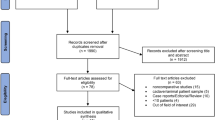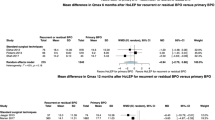Abstract
BACKGROUND:
The introduction of laser therapies for the management of bladder outlet obstruction in men with BPH has challenged the gold standard treatment, TURP. We sought to compare the changing clinical characteristics of patients undergoing TURP and laser vaporization of the prostate (LVP) over time.
METHODS:
The American College of Surgeons National Surgical Quality Improvement Program (ACS-NSQIP) database was queried for men who underwent TURP and LVP from 2007 to 2012. Patient demographics, clinical and intraoperative characteristics and 30-day postoperative outcomes were analyzed.
RESULTS:
In all, 12 645 men met inclusion criteria, of whom 65% underwent TURP and 35% underwent LVP. Overall, men undergoing TURP were more likely to be scheduled as an emergency (3% vs 1%, P<0.001), have shorter operative times (53 vs 56 min, P<0.001), longer hospital stays (2.4 vs 1.0 days, P<0.001), more frequent blood transfusions (2.1% vs 0.6%, P<0.001) and more postoperative complications including: pneumonia (0.5% vs 0.3%, P=0.02), septic shock (0.3% vs 0.1%, P=0.045), and reoperation within 30 days (2.2% vs 1.4%, P=0.06). However, between 2007 and 2012, there was a significant trend for men undergoing TURP to have increased functional independence (93–96%, P<0.01) and American Society of Anesthesiology (ASA) Physical Class I categorization (0.6–5.1%, P<0.001). In contrast, over the same time period, there was a trend for men undergoing LVP to be significantly older (71–73 years, P<0.001) and have an increased hospital stay (0.50 days to 1.30 days, P=0.03).
CONCLUSIONS:
Statistically significant differences in clinical characteristics of patients undergoing TURP and LVP have historically existed. However, since 2007, the characteristics of patients undergoing LVP and TURP have changed significantly. Further studies are required to compare these patient characteristics with specific urologic variables and to evaluate clinically significant changes in these cohorts.
This is a preview of subscription content, access via your institution
Access options
Subscribe to this journal
Receive 4 print issues and online access
$259.00 per year
only $64.75 per issue
Buy this article
- Purchase on Springer Link
- Instant access to full article PDF
Prices may be subject to local taxes which are calculated during checkout
Similar content being viewed by others
References
Wei JT, Calhoun E, Jacobsen SJ . Urologic diseases in America Project: benign prostatic hyperplasia. J Urol 2008; 179: S75–S80.
Zhang X, Geng J, Zheng J, Peng B, Che J, Liang C et al. Photoselective vaporization versus transurethral resection of the prostate for benign prostatic hyperplasia: a meta-analysis. J Endourol 2012; 26: 1109–1117.
Gravas S, Bachmann A, Reich O, Roehrborn CG, Gilling PJ, De La Rosette J et al. Critical review of lasers in benign prostatic hyperplasia (BPH). BJU Int 2011; 107: 1030–1043.
Costello AJ, Bowsher WG, Bolton DM, Braslis KG, Burt J . Laser ablation of the prostate in patients with benign prostatic hypertrophy. Br J Urol 1992; 69: 603–608.
Hai MA, Malek RS . Photoselective vaporization of the prostate: initial experience with a new 80 W KTP laser for the treatment of benign prostatic hyperplasia. J Endourol Endourol Soc 2003; 17: 93–96.
Teng J, Zhang D, Li Y, Zhu X, Teng JF, Wang K et al. Photoselective vaporization with the green light laser vs transurethral resection of the prostate for treating benign prostate hyperplasia: a systematic review and meta-analysis. BJU Int 2013; 111: 312–323.
Ruszat R, Wyler S, Forster T, Reich O, Stief CG, Gasser TC et al. Bladder outlet obstruction: safety and effectiveness of photoselective vaporization of the prostate (PVP) in patients on ongoing oral anticoagulation. Eur Urol 2007; 51: 1031–1041.
Yu X, Elliott SP, Wilt TJ, McBean AM . Practice patterns in benign prostatic hyperplasia surgical therapy: the dramatic increase in minimally invasive technologies. J Urol 2008; 180: 241–245.
Anon: Home | ACS NSQIPACS NSQIP | Surgical Quality Improvement. Available at: http://site.acsnsqip.org/, accessed 1 May 2014.
Deyo RA, Cherkin DC, Ciol MA . Adapting a clinical comorbidity index for use with ICD-9-CM administrative databases. J Clin Epidemiol 1992; 45: 613–619.
Schroeck FR, Hollingsworth JM, Kaufman SR, Hollenbeck BK, Wei JT . Population based trends in the surgical treatment of benign prostatic hyperplasia. J Urol 2012; 188: 1837–1841.
Strope SA, Yang L, Nepple KG, Andriole GL, Owens PL . Population based comparative effectiveness of transurethral resection of the prostate and laser therapy for benign prostatic hyperplasia. J Urol 2012; 187: 1341–1345.
Thangasamy IA, Chalasani V, Bachmann A, Woo HH . Photoselective vaporisation of the prostate using 80-W and 120-W laser versus transurethral resection of the prostate for benign prostatic hyperplasia: a systematic review with meta-analysis from 2002 to 2012. Eur Urol 2012; 62: 315–323.
Bachmann A, Tubaro A, Barber N, d'Ancona F, Muir GWitzsch U . 180-W XPS GreenLight laser vaporisation versus transurethral resection of the prostate for the treatment of benign prostatic obstruction: 6-month safety and efficacy results of a European Multicentre Randomised Trial—the GOLIATH study. Eur Urol 2014; 65: 931–942.
Cornu J-N, Ahyai S, Bachmann A, de la Rosette J, Gilling P, Gratzke C et al. A systematic review and meta-analysis of functional outcomes and complications following transurethral procedures for lower urinary tract symptoms resulting from benign prostatic obstruction: an update. Eur Urol 2014; S0302-2838(14): 00538–7.
Tang K, Xu Z, Xia D, Ma X, Guo X, Guan W et al. Early outcomes of thulium laser versus transurethral resection of the prostate for managing benign prostatic hyperplasia: a systematic review and meta-analysis of comparative studies. J Endourol Endourol Soc 2014; 28: 65–72.
Woo HH, Hossack TA . Photoselective vaporization of the prostate with the 120-W lithium triborate laser in men taking coumadin. Urology 2011; 78: 142–145.
Bolton DM, Costello AJ . Management of benign prostatic hyperplasia by transurethral laser ablation in patients treated with warfarin anticoagulation. J Urol 1994; 151: 79–81.
Chung DE, Wysock JS, Lee RK et al. Outcomes and complications after 532 nm laser prostatectomy in anticoagulated patients with benign prostatic hyperplasia. J Urol 2011; 186: 977–981.
Spernat DMG, Hossack TA, Woo HH . Photoselective vaporization of the prostate in men taking clopidogrel. Urol Ann 2011; 3: 93–95.
Acknowledgements
This study had philanthropic support from the Division of Urology and the John and Carol Walter Center for Urological Health, NorthShore University HealthSystem.
Author information
Authors and Affiliations
Corresponding author
Ethics declarations
Competing interests
The authors declare no conflict of interest.
Rights and permissions
About this article
Cite this article
Malik, R., Wang, C., Lapin, B. et al. Comparison of patients undergoing laser vaporization of the prostate versus TURP using the ACS-NSQIP database. Prostate Cancer Prostatic Dis 18, 18–24 (2015). https://doi.org/10.1038/pcan.2014.39
Received:
Revised:
Accepted:
Published:
Issue Date:
DOI: https://doi.org/10.1038/pcan.2014.39
This article is cited by
-
Laser enucleation of the prostate versus transurethral resection of the prostate: perioperative outcomes from the ACS NSQIP database
World Journal of Urology (2020)
-
Critical reviews of 1470-nm laser vaporization on benign prostatic hyperplasia
Lasers in Medical Science (2018)
-
Comparison of Patients Undergoing PVP Versus TURP for LUTS/BPH
Current Urology Reports (2015)



